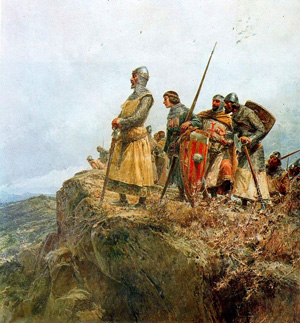Peter III had recalled Roger of Lauria and he finally arrived in late August from Sicily where he had been besieging Taranto and generally raiding along the Apulian coast. In combination with the Catalan squadron at Barcelona, Roger began to attack French supply lines with devastating results.
Sometime around September 1st, vice-admirals Raymond Marquett and Berenguer Mallol set out with eleven galleys to reconnoiter Rosas in an attempt to ambush one of the dispersed French units. They were apparently spotted, and Admiral William of Lodève pursued them with 24 galleys from Las Rosas. While the French had numerical superiority, the losses of personnel they had incurred during the previouse years had crippled the fleet and in a night battle off Rosas, the 11 Catalan galleys managed to capture half of the French galleys. This defeat was followed by another night battle off Las Formigueras on September 4th. The already weakened French fleet of 30 galleys ran into Roger of Lauria with approximately 40 galleys. As in previous battles, the French found they could not rely on their allies for the Genoese galleys turned and fled at first contact. (For more on Genoese behavior in the war see: Trade as a Weapon article.) The result of the defection of the 10 Genoese galleys was that Roger was able to descend on the French fleet and decimate it, capturing between 15 and 20 galleys. More importantly, with the French completely removed from the area, Roger was able to attack Rosas, burning the entire fleet anchored there and all the supplies. Gerona would fall three days later, but the French effort had been damaged beyond repair.

In one of the more dramatic scenes of the war, the Count of Foix and Ramon Roger were sent by the King of France to Roger of Lauria at Cadaqués to ask for a truce. Roger replied that no truce would be granted under any circumstance and that regardless of the number of galleys sent against him, he had no fear that he could not defeat them. He then allegedly said, "Nor do I think he (the King of France) dares to put on the water any galley or other ship without the safe-conduct of the King of Aragon. And not only any galley or leny, but I believe no fish goes on the sea unless it carries the coat of arms of the King of Aragon on its tail to show the safe-conduct of the king." Foix reportedly smiled at this seemingly brash statement, but the Angevins would not find the words so humorous by 1292.
Having been refused safe passage, the French tried to forced the pass across the Pyrenees. In a two day running fight between September 29th and October 1st, known as the Battle of the Col de Panissars, Peter III's troops decimated the French forces (Painting of Peter III at Col de Panissars). Plagued by pestilence, the guerrilla tactics of Peter III, and a lack of supplies, the French crusaders straggled back over the Pyrenees to Perpignan where Philip III died of illness on October 5, 1285. According to Muntaner, on news of the victory Barcelona broke out in eight days of celebration. Though Peter III had vanquished the papacy and the French crown, he would not have long to enjoy his triumph. While preparing to invade Mallorca to punish his brother for his support of the crusade, Peter fell ill and died on November 11, 1285.
The year 1285 had proved fateful, for with the passing of Peter, every major player who had been involved with the start or the conduct of the War of the Sicilian Vespers, except Roger de Lauria, was dead by the end of that year. With the removal of the main instigators, the war entered a new phase, though it was not immediately evident to those involved.


